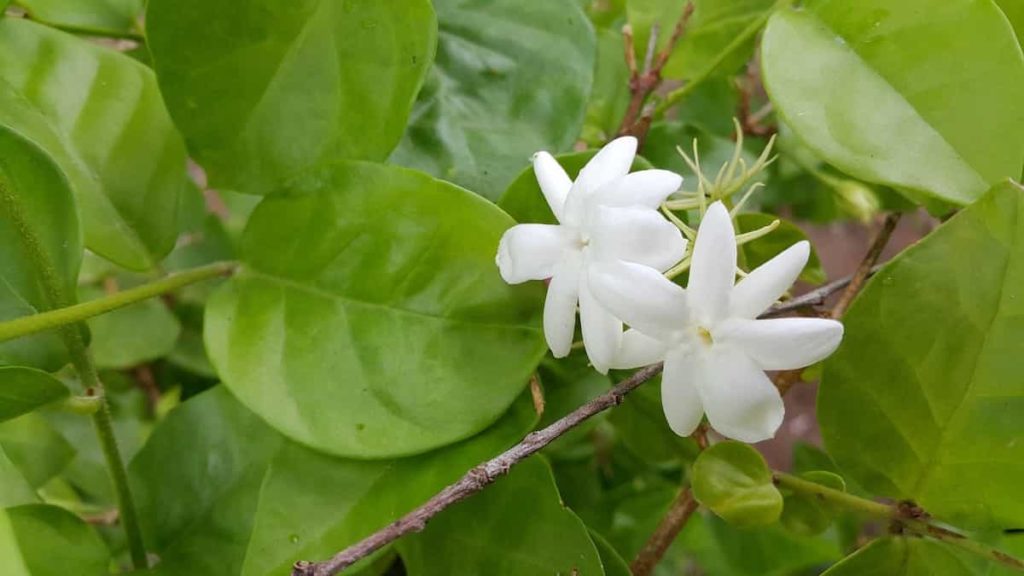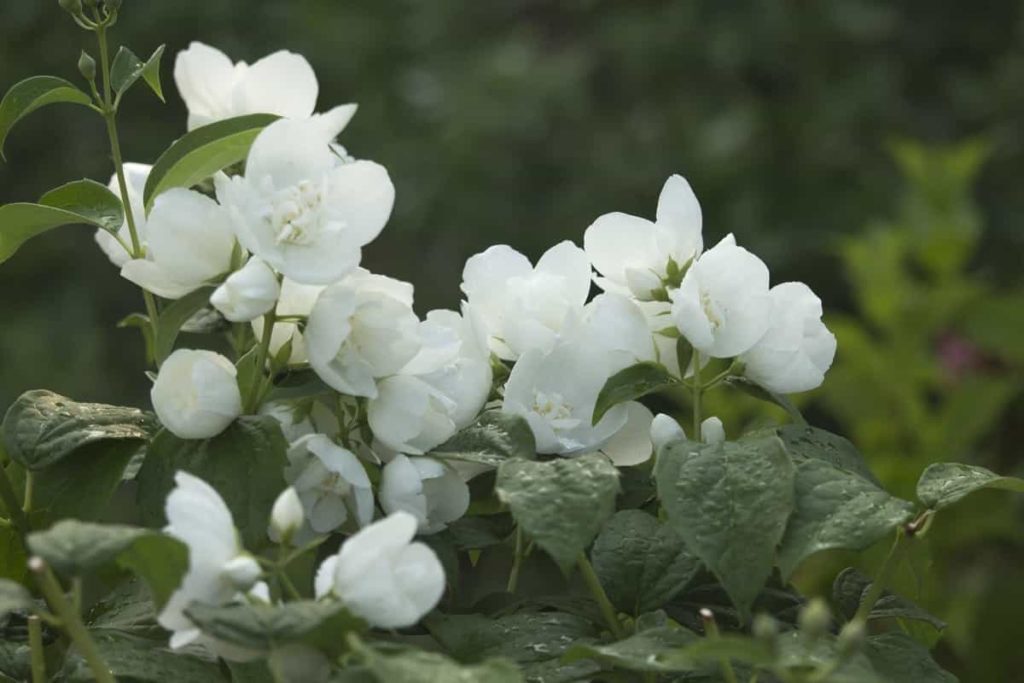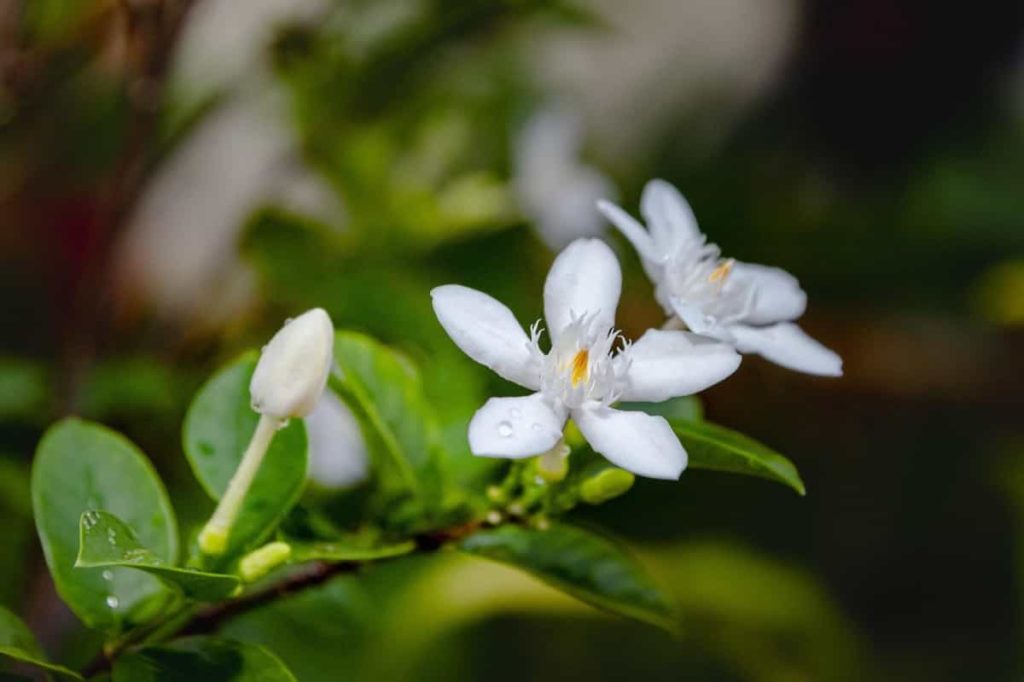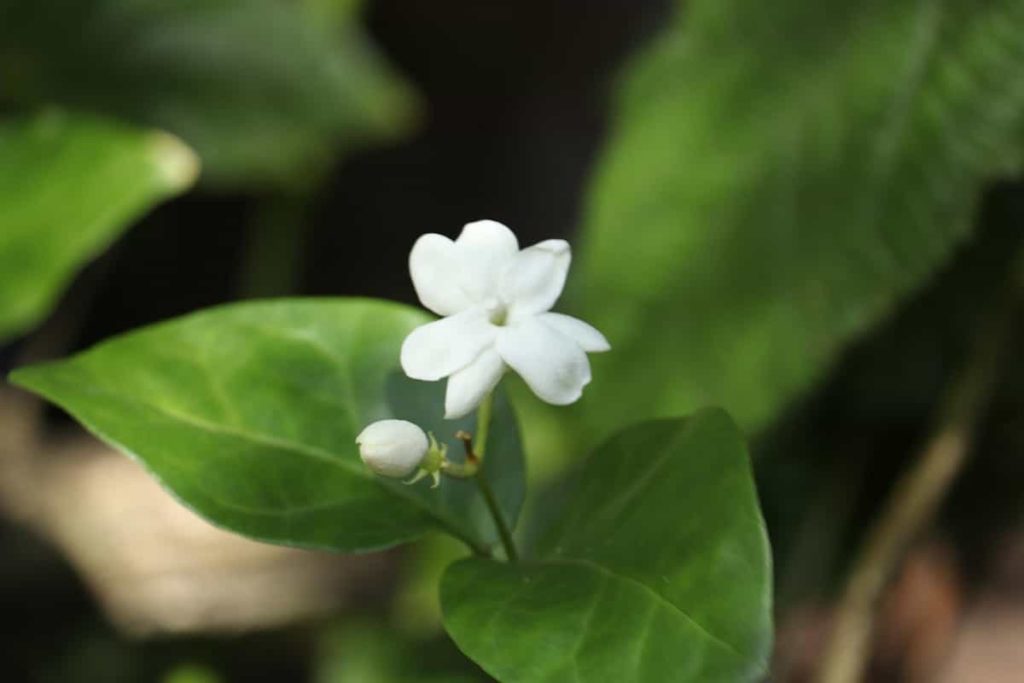Intensely fragrant, jasmine is renowned for its captivating flowers that attract pollinators from throughout the globe. While most jasmine flowers are a pale white, a few varieties are yellow or cream. Potted jasmine can be used as an indoor houseplant. Alternatively, it can be grown as bushes or ground cover in the soil and trained to climb. Nowadays, many people are trying to grow jasmine flowers in their house as it is easy to grow and gives a fantastic fragrance.

This article can be a guide to growing jasmine indoors, in pots, or outdoors in the backyard for people in the USA. Many Indians in the USA are also wondering how to grow jasmine in the states they reside in since jasmine is one of the popular home flowers in India. This article provided information on how to grow jasmine in the USA in containers, indoors and outdoors, and in the backyard directly in the soil. We hope this information will be your manual for growing jasmine at your home in the USA.
Steps to grow Jasmine flowers at home in the USA
Know your zone in the USA
Some plants can resist winter cold more than others, and whether or not they are considered cold-hardy depends on the species. Climbing vines of the Jasmine species with delicate, fragrant flowers thrive in USDA zones 9 or 10 of the USA. Seasonal jasmine thrives in USDA zone 6 outdoors. USDA zone 7 can withstand two species, whereas USDA zone 8 can support two.
Select an ideal location for growing Jasmine
Learn about the specific environmental requirements of your jasmine variety by doing a little research. Jasmine needs the perfect amount of sunlight and the ideal temperature to grow. Choose a location for your jasmine based on the following considerations:
For the most part, Jasmine plants need full light, while certain varieties may tolerate some partial shade. You should know whether or not the jasmine you’ve picked will survive in the open air or whether it’s better suited to a container inside, where you have more control over its environment.
In case you missed it: Jasmine Gardening For Beginners – How to Start, FAQs

If you’re going to plant outdoors, look for a site that will be as warm as possible. Some varieties are vines that climb buildings and fences, while others grow along the ground and offer superb ground cover. Select a location for your plantings based on the species you have at your home in the USA.
How to grow jasmine from seeds?
Around three months before you want to plant your jasmine outside in the USA, start the seeds inside. Before planting, soak the seeds for 24 hours. Soak the soil in the six-pack cells fully before filling them with potting soil—plant one seed in each cell after allowing it to drain. Placing the six-packs in direct sunshine will help keep them fresh.
While the seedlings are sprouting, keep the soil wet. A gallon-sized planter should be used for each seedling as soon as it has two sets of genuine leaves. Before moving the plants outside, keep them inside for at least a month, or cultivate your jasmine as a houseplant the first year.
How to grow the Jasmine plant from cuttings?
Make cuttings from the stem tips of a healthy jasmine plant to begin roots. Using a pair of scissors, cut each cutting approximately 6 inches long. Remove the leaves and dip the cutting in rooting hormone powder. Put the cuttings in a planter filled with damp sand and cover the container with a plastic bag to keep the cuttings wet. Keep the planter in a room that is 75 degrees Fahrenheit. Within a month, the roots of the jasmine plants should grow strong enough to be transplanted into potting soil, where they will be able to establish a strong root system.
How to grow jasmine from the layering method?
After bending a branch in a U-shape, remove the leaves at the node to begin layering jasmine. Cover the stem with soil once it has been sent to the ground level. Put some weight on it so that it doesn’t move. If possible, expose the stem’s tip to some direct sunlight. Keep the soil wet by watering the plant a bit. Within a few months, a plant’s roots will be fully developed. Place the new plant in soil or landscaping and wait for the leaves to develop before separating it.
In case you missed it: Homemade Fertilizers For Jasmine – Organic/Natural

How to care for Jasmine plants in pots/containers?
Prepare the potting mix for Jasmine
For growing jasmine in pots outside or inside, the first step is to prepare the potting mix. Jasmine thrives on well-drained soil. To enhance the soil’s ability to drain, use a potting mix that has a loam basis or add loam-based compost to the pot. To prevent overwatering the plant, pick a flower container with drainage holes. Fill a 12-inch-deep hole with water to test the soil’s drainage. Well-draining soil drains in 5-15 minutes.
Place the Jasmine container at an ideal location
When it comes to growing, jasmine likes it warm with plenty of shade. So place your jasmine container in an area that gets some sunshine and gets shade. Consider placing the pot near a south-facing window for maximum sunshine exposure if you’re putting it inside.
Planting the Jasmine plant
Get some soil and spread it over the seed. Ensure the crown of the seedling is level with the soil before planting. Completely cover the roots. You can speed up a seedling’s adaptation to its new surroundings by loosening the roots with your hands before you plant it. Most garden stores in the USA and nurseries sell jasmine seeds and seedlings. You can get them there.
Watering the Jasmine plant
Water your plant until the drainage holes are dry using a watering can or hose. It should be moist but not flooded after you’re done watering. The soil will be moistened, and your plant will be able to adapt to its new environment if you water it right away. Spray the newly planted jasmine with a watering container or spray bottle for optimal effects.
It is essential to maintain the soil and the plant well-watered. Depending on the climate, water the plant once a week or whenever the soil becomes dry. If you’re unsure whether or not to water the plant, stick your finger in the earth approximately 1–2 inches deep. Water the jasmine if the soil is too dry for it to grow.
How to grow jasmine in the backyard?
Soil requirements for growing Jasmine outdoors
Although some exceptions exist, rich, well-draining soil is desirable for most jasmine varieties. A 2-inch layer of compost should be added to the soil where you wish to grow your jasmine. Jasmine will thrive throughout the growing season thanks to this method. You should ensure the area where you wish to plant drains adequately before beginning.
In case you missed it: Growing Jasmine In Balcony – Planting Guide For Pots

Fill a hole with water and excavate it. A well-drained area is one in which water rapidly soaks into the hole and then exits. Choose an alternative location if the water sits and drains too slowly in the area you want to plant.
Planting the Jasmine in the backyard
Water the root ball of the jasmine plant after carefully removing it from its container. Scratch the roots all over carefully to get their attention. Next, place the jasmine plant in a hole two times the diameter of the root ball. Soil surrounding the hole should be somewhat higher than the soil level of your plant to serve as a reservoir for rainwater and water supply. The base of the jasmine plant should be lightly patted with soil to keep it in place.
To aid in the establishment of the plant, thoroughly wet the soil surrounding the base. Keep the jasmine upright if required by adding more soil. While purchasing a young jasmine plant is the most frequent method of planting it, jasmine can also be started from seed. According to the cultivar, the germination rate of jasmine seeds is quite low. Therefore, you can start the seeds inside in seed pots filled with seed starting mix once the final frost has gone. The seedlings can then be hardened off and planted outdoors.
Cuttings from a mature jasmine plant can also be used to start a jasmine garden. Cut healthy 6-inch jasmine stems in the middle of the summer or the autumn seasons of the USA. Put the stems into a container with a combination of soil and compost. Transplant the pot in the spring after it has spent the winter in a bright window.
Watering requirements for growing Jasmine in backyards
In bloom, jasmine plants need plenty of water. Maintain the soil slightly wet at all times. Water the plants once a week, but if the soil is already dry, you can water them earlier.
Fertilizer requirements for Jasmine
Use potassium and phosphorus-rich fertilizer on Jasmine plants when fertilizing them. Use this fertilizer to lengthen the blooming period of the plant. In the spring and summer seasons of the USA, liquid fertilizer can be supplied to indoor Jasmine plants several times each week during the growing season.
Pest and diseases management in Jasmine
Rust and blight are typical problems with jasmines since they are tropical plants. Foliage damage, wilting, and even transmission to younger stems or cuttings taken from the mature plant are possible outcomes of these two circumstances. Fungal problems like these need baking soda spray and a lot of ventilation. It’s possible that cleaning the pot and the roots will be necessary if this problem continues.
Insects like aphids, whiteflies, and mites drain the life force out of Jasmine plants, but the leaves can also be eaten away by caterpillars, budworms, and webworms. Most pests that might harm your Jasmine plants can be eliminated by spraying the leaves with a soapy solution. Insecticide sprays can target certain pests if you know what they are.
In case you missed it: Growing Jasmine Plants in Pots from Cuttings and Seed

How do grow Jasmine flowers faster?
Jasmine can thrive in full sun or moderate shade, depending on your location in the USA. Winter jasmine, for example, prefers a more shady location than summer jasmine, which prefers full light. Jasmine thrives on relatively productive, well-drained yet wet, somewhat fertile sandy, loamy soil. For a month, don’t fertilize the jasmine. After that, please give it a dose of water-soluble 7-9-5 fertilizer to help it blossom. Instead of watering regularly, use a solution made from 1/4 teaspoon of fertilizer and 1 gallon of water during the summer. Take care of these parameters to grow your jasmine plant faster.
How to harvest Jasmine?
Jasmine plants produce a lot of blossoms throughout the year in the USA, so you may wish to bring some of them inside for display. Pruning branches that are overflowing with flowers and leaves requires a pair of sharp pruning shears. Place the stems in a bowl of water as soon as possible to keep them fresh. When your jasmine develops blossom buds in spring and summer, you can prepare your jasmine tea. When brewed with green tea leaves, jasmine tea is considered to offer healing effects.
Jasmine plant care indoor
This plant thrives in a cool, well-lit room or a window that gets a lot of sunlight. When growing jasmine indoors, good air circulation is key to promoting the spectacular white winter blossoms of the plant. The plant can withstand four hours of direct sunshine each day from late spring to autumn. In the winter, reduce the amount of sunshine that reaches your skin. Indoor jasmine plants need porous soil that may be improved with organic materials such as bark, coir, or peat moss.
Growing Jasmine Hydroponically – A Full Guide

The soil combination should be wet all year long but not squishy. After the bloom has faded, the plants require less water. During the growth season, a weaker houseplant food should be used to feed indoor jasmine. More extended flower periods can be achieved by using high phosphorus fertilizer. To tell whether your plant has mealybugs, look for white, cottony masses beneath and around the stems. Whenever you’re pruning, get rid of all of them. After completing pruning, use an alcohol-soaked cotton swab to remove any remaining lumps.
When growing jasmine indoors, pruning is a crucial part of the process. To avoid a jasmine houseplant from becoming out of hand while learning how to care for it, you’ll want to trim it periodically. While the twining vine is being directed to support, do a heavy spring pruning. When cared for correctly, indoor jasmine plants may last a long time. The spring is a good time for repotting. The roots should be pruned while transplanting to new soil, if necessary.
- How to Grow Hibiscus from Flower
- Plantation Ideas for Home Decoration: A Beginners Guide
- Flower Garden Designs and Layouts for Beginners
- Planting and Spacing Techniques in Papaya: A Beginner’s Guide
- Growing Gold: Essential Techniques for Planting Pineapples
- How to Make Kalanchoe Plant Bushy: Home Remedies and Solutions
- 11 Reasons Why Your Gardenia is Not Blooming: Home Remedies and Solutions
- Eco Elegance: The Guide to Designing a Drought-Tolerant Landscape
- Gardening on a Slope: Strategies for Hillside Landscaping
- Nourish and Flourish: Top Organic Mulches for Thriving House Plants
- Everything You Want to Know about Indian Mogra Flower: Discover Uses and Growing
- Green Thumb Success: Expert Tips for Cultivating Greenhouse Pumpkins All Year Round
- Maximize Growth & Flavor: The Ultimate Guide to Companion Planting in Herb Gardens
- How to Control Rhododendron Problems Naturally: Home Remedies and Organic Ways to Fix Them
- Natural Magic: The Remarkable Benefits of Cinnamon for Plants
- Best Steps to Revive Dying Tulip with Natural and Organic Treatment
- 10 Reasons Why Your Angel Trumpet is Not Blooming: Remedies and Treatment
- How to Fix Periwinkle Leaf and Flower-Related Problems: Natural Remedies and Solutions
- How to Fix Zinnias Leaf and Flower Problems: Discover Natural and Home Remedies
- Organic Steps to Induce Lemon Tree Flowers: A Comprehensive Guide
- Bloom Booster: Crafting the Perfect Homemade Bougainvillea Fertilizer
- Optimizing Growth: A Guide to Applying NPK Fertilizer for Potted Plants
- 10 Best Homemade Fertilizers for Rubber Plant: DIY Recipes and Application Method
- How to Boost Female Pumpkin Flowers: Effective Steps for More Flowers and High Yields
- Transform Your Indoor Garden: Top Benefits of Pink Salt for Houseplants
- 10 Best Homemade Fertilizers for Peacock Plants (Calathea): Easy DIY Guide
- Unlock Blooms: 9 Reasons Why Your Potted Chrysanthemum is Not Blooming
- 8 Reasons Why Your Potted Hibiscus is Not Blooming: Fix it with Simple Solutions
- Unlock Blooms: 9 Key Reasons Your Potted Frangipani Won’t Flower
- 10 Reasons Why Is My Ice Plant Not Blooming: Remedies and Treatment
- 10 Reasons Why My Potted Hydrangea Not Blooming: Treatment and Remedies
- 10 Reasons Why is My Wisteria Not Blooming: Remedies and Treatment
- 10 Reasons Why is My Goldfish Plant Not Blooming: Remedies and Treatment
- Maximize Your Space: Ultimate Guide to Balcony Gardening with Grow Bags
- 10 Reasons Why Your Iris is Not Blooming: Remedies and Treatment
- 10 Reasons Why Your Anthurium Plant is Not Blooming: Treatment and Remedies